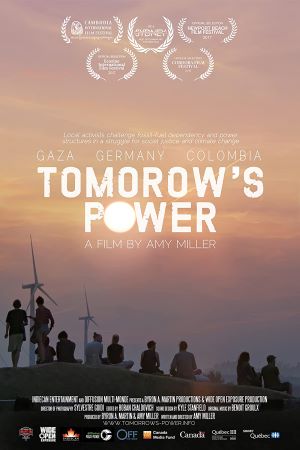
Tomorrow's Power 2017
Distributed by Good Docs
Produced by Amy Miller and Byron A. Martin
Directed by Amy Miller
Streaming, 76 mins
College - General Adult
Activism; Environmentalism
Date Entered: 09/26/2023
Reviewed by Abbey B. Lewis, STEM Engagement Librarian, University of Colorado BoulderTomorrow’s Power opens with a horrifying situation - a hospital in Gaza experiencing regular power outages that threaten the lives of patients. An emergency room surgeon describes occasions when the lights have cut out mid-operation. The film shifts to Arauca, Columbia, where the combination of multinational corporations drawn in by oil-rich land and hostile government policies have created difficult living conditions and threatened the ability of local farmers to maintain their livelihoods. In a third location, Rhineland, Germany, climate activists find that the green energy revolution has reached a confounding hitch. After phasing out nuclear energy and increasing the capacity for production of solar and wind power, coal production has also increased to a point where Germany is one of the world’s largest producers of carbon dioxide.
As harrowing as this introduction is, the majority of the film is infused with hope, featuring innovative solutions that are guiding these regions to more socially-just and environmentally sustainable futures. The solutions themselves range from technologies like the solar panels that provide reliable power to Gaza’s hospitals and schools, to services like clean water and community-run grocery stores that allow Arauca’s campesino community to thrive, to civil disobedience strategies used by veteran Rhineland activists during the anti-nuclear movement that they now apply to stopping the production of coal. The nature of each situation is markedly different from the others, but the film’s overall message is clear: solutions to these challenges lie in the hands of ordinary people who organize together for the greater good.
The message itself is delivered directly from the activists as they speak about the progress and challenges they’ve witnessed. An overarching narrator may have helped to form connections between the three regions but would also have de-centered the activists within their own stories. This leaves a rich opportunity for instructors to ask students to consider those connections for themselves or to think how strategies, challenges, and successes from the film may look in other contexts that are being examined in a course.
The activism in Rhineland coal fields might seem incongruous with the movements in Gaza and Arauca. This is a wealthy nation, and one that’s well known for sustainable development. Furthermore, the armed conflict that spurs and complicates the activism in Gaza and Arauca is notably absent here. Yet, the filmmakers’ choice to explore activism in Rhineland is still solid. Wealthy nations are not immune from climate change and the capitalism, industrialization, and permissive government policies behind the environmental damage perpetuated there should not be considered less harmful aggressors. Gaza and Arauca effectively connect climate issues with human rights issues, but also run the risk of being unrelatable for viewers who are fortunate enough to live without concern for power outages in hospitals or the economic devastation wrought by multinational companies and the War on Drugs. Rhineland demonstrates this same connection, conveying a sense of urgency and threat that is less possible to ignore because of its familiarity.
Tomorrow’s Power would be a strong choice for college courses studying social movements, especially environmental activism. It may also find a place in public libraries where local activists are contemplating strategies and seeking inspiration from other successful movements. It’s recommended because of its inside view of grassroots activism in social and environmental contexts. Audiences will be sure to find themselves thinking about possibilities for change within their own reach.
Awards:Sydney World Film Festival 2016, Best Documentary Feature Film
Published and licensed under the Creative Commons Attribution 4.0 license. Anyone can use these reviews, so long as they comply with the terms of the license.